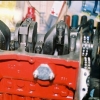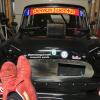Brake And Clutch Fluid Capacity
#1

Posted 29 August 2016 - 07:48 PM
Andy.
#2

Posted 29 August 2016 - 07:56 PM
AP Racing DOT 5.1.
http://www.demon-twe...GV95xoCPu3w_wcB
Three of these should be more than enough, and leave you with plenty to bleed/top-up. ![]()
#3

Posted 29 August 2016 - 07:58 PM
To bleed it fully I'd have at least a litre of it available.
#4

Posted 29 August 2016 - 08:29 PM
If you're thinking of swapping over to Silicon, really to get the benefit from it, you need to replace all rubber components in these systems.
Silicon is good, but quite fussy to use, though once in the system is almost maintenance free.
I have it in a couple of cars, but was done from refurbishment. I certainly wouldn't bother trying to retro fill a system that has had traditional fluids in it.
#5

Posted 31 August 2016 - 12:07 PM
The two types of fluid can react to produce crystallisation which results in seal failure.
But don't be put off by those who say silicone is inferior. The evidence is to the contrary. I ran several cars for many years with silicone fluid, each time after a full system overhaul. It is basically fit and forget unlike the conventional fluid, which becomes downright dangerous after a couple of years due to depressed boiling point caused by dissolved water.
Silicone will be difficult to bleed. There gas been almost an epidemic of people lately with bleeding problems. If you are skilled at brake bleeding you probably have no need to be concerned, but otherwise maybe a good DOT4 fluid is what you should use, and change it every 18 months or so.
#6

Posted 01 September 2016 - 08:44 AM
You could look at something like Castrol React ... was Response ... use that in my Alfa and it's been fine for about 4 years so far.
#7

Posted 01 September 2016 - 11:25 AM
#8

Posted 01 September 2016 - 11:54 AM
But don't be put off by those who say silicone is inferior. The evidence is to the contrary
I wonder why the major user of it is trying to bin it?
#9

Posted 01 September 2016 - 12:02 PM
silicon (DOT5) has issues. it does not hold water. it is lighter than water. it holds air.
so any water in the system pools in the lowest point and normally causes rust in that area. which tends to be where the seals move over it. also as it is near the point of heat it boils first rendering the brakes not good at all.
bleeding needs to be done very carefully as the pumping action can introduce bubbles leaving a poor pedal feel. (as the fluid is more viscous the bubbles do not move out of it as easily).
so if the car is a trailer queen and will not really be driven it is a good option as it does not effect paint. but to me that is the only good thing. I drive my cars so would never consider it. It was bad enough in the MTB brakes.
so reading from Moss
Bleeding Water from Systems with Silicone Fluid
http://www.mossmotor...luid/page4.html
Because even a tiny amount of water will lead to corrosion, and water in a caliper or wheel cylinder can boil at relatively low temperatures, it is advisable to bleed the system every six to 12 months to eliminate the water.
Hazard to Paint
Unlike glycol fluids, silicone fluids do not damage paint. This is of particular importance in regard to show cars where a spill or leak of glycol fluid can have seriously ugly results. A newly rebuilt and scrupulously clean brake system filled with silicone fluid should outlast a system filled with glycol fluid by several times.
At this point, the silicone fluids have what appears to be an obvious advantage over glycol based fluids. Given all the trouble caused by water contamination of glycol based brake fluid, silicone fluid has some appeal. However there are some drawbacks, and we need to understand those before we start making choices.
#10

Posted 01 September 2016 - 12:42 PM
back to the original post, depending on your master cylinder reservoir , i think 1 x 500 ml would fill it, but by the time you bleed , lose some etc, it may just tip you over into a second bottle.... i doubt it but cant say for sure.
1 user(s) are reading this topic
0 members, 1 guests, 0 anonymous users


















